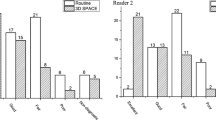Abstract
Hypothalamic hamartomas are relatively rare, non-neoplastic congenital malformations. With conventional MR images alone, small hypothalamic hamartomas may be difficult to diagnose because of artifacts from cerebrospinal fluid. We present the usefulness of three-dimensional constructive interference in steady state sequence for evaluating small hypothalamic hamartomas in three pediatric patients.


Similar content being viewed by others
References
Boyko OB, Curnes JT, Oakes WJ, Burger PC (1991) Hamartomas of the tuber cinereum: CT, MR, and pathologic findings. Am J Neuroradiol 12:309–314
Lona Soto A, Takahashi M, Yamashita Y, Sakamoto Y, Shinzato J, Yoshizumi K (1991) MRI findings of hypothalamic hamartoma: report of five cases and review of the literature. Comput Med Imaging Graph 15:415–421
Arita K, Ikawa F, Kurisu K et al. (1999) The relationship between magnetic resonance imaging findings and clinical manifestations of hypothalamic hamartoma. J Neurosurg 91:212–220
Debeneix C, Bourgeois M, Trivin C, Sainte-Rose C, Brauner R (2001) Hypothalamic hamartoma: comparison of clinical presentation and magnetic resonance images. Horm Res 56:12–18
Casselman JW, Kuhweide R, Deimling M, Ampe W, Dehaene I, Meeus L (1993) Constructive interference in steady state-3D FT MR imaging of the inner ear and cerebellopontine angle. Am J Neuroradiol 14: 47–57
Stuckey SL, Harris AJ, Mannolini SM et al. (1996) Detection of acoustic schwannoma: use of constructive interference in the steady state three-dimensional MR. Am J Neuroradiol 17:1219–1225
Ikushima I, Korogi Y, Hirai T et al. (1997) MR of epidermoids with a variety of pulse sequences. Am J Neuroradiol 18:1359–1363
Yang D, Korogi Y, Ushio Y, Takahashi M (2000) Increased conspicuity of intraventricular lesions revealed by three-dimensional constructive interference in steady state sequences. Am J Neuroradiol 21:1070–1072
Govindappa SS, Narayanan JP, Krishnamoorthy VM, Shastry CH, Balasubramaniam A, Krishna SS (2000) Improved detection of intraventricular cysticercal cysts with the use of three-dimensional constructive interference in steady state MR sequences. Am J Neuroradiol 21:679–684
Hirai T, Korogi Y, Shigematsu Y et al. (2000) Evaluation of syringomyelia with three-dimensional constructive interference in a steady state (CISS) sequence. J Magn Reson Imaging 11:120–126
Held P, Fellner C, Fellner F et al. (1997) MRI of inner ear and facial nerve pathology using 3D MP-RAGE and 3D CISS sequences. Br J Radiol 70:558–566
Shigematsu Y, Korogi Y, Hirai T et al. (1998) Virtual MRI endoscopy of the intracranial cerebrospinal fluid spaces. Neuroradiology 40:644–650
Yousry I, Camelio S, Wiesmann M et al. (1999) Detailed magnetic resonance imaging anatomy of the cisternal segment of the abducent nerve: Dorello canal and neurovascular relationships and landmarks. J Neurosurg 91:276–283
Held P, Nitz W, Seitz J et al. (2000) Comparison of 2D and 3D MRI of the optic and oculomotor nerve anatomy. Clin Imaging 24:337–343
Seitz J, Held P, Frund R et al. (2001) Visualization of the IXth to XIIth cranial nerves using 3-dimensional constructive interference in steady state, 3-dimensional magnetization-prepared rapid gradient echo and T2-weighted 2-dimensional turbo spin echo magnetic resonance imaging sequences. J Neuroimaging 11:160–164
Yousry I, Moriggl B, Dieterich M, Naidich TP, Schmid UD, Yousry TA (2002) MR anatomy of the proximal cisternal segment of the trochlear nerve: neurovascular relationships and landmarks. Radiology 223:31–38
Mateijsen DJ, Van Hengel PW, Krikke AP, Van Huffelen WM, Wit HP, Albers FW (2002) Three-dimensional Fourier transformation constructive interference in steady state magnetic resonance imaging of the inner ear in patients with unilateral and bilateral Meniere disease. Otol Neurotol 23:208–213
Fushimi Y, Miki Y, Ueba T et al. (2003) Liliequist membrane: three-dimensional constructive interference in steady state MR imaging. Radiology 229:360–365
Bradley WG, Glenn BJ (1987) The effect of variation in slice thickness and interslice gap on MR lesion detection. Am J Neuroradiol 8:1057–1062
Haacke EM, Wielopolski PA, Tkach JA, Modic MT (1990) Steady-state free precession imaging in the presence of motion: application for improved visualization of the cerebrospinal fluid. Radiology 175:545–552
Martin DD, Seeger U, Ranke MB, Grodd W (2003) MR imaging and spectroscopy of a tuber cinereum hamartoma in a patient with growth hormone deficiency and hypogonadotropic hypogonadism. Am J Neuroradiol 24:1177–1180
Freeman JL, Coleman LT, Wellard RM et al. (2004) MR imaging and spectroscopic study of epileptogenic hypothalamic hamartomas: analysis of 72 cases. Am J Neuroradiol 25:450–462
Author information
Authors and Affiliations
Corresponding author
Rights and permissions
About this article
Cite this article
Yamura, M., Hirai, T., Korogi, Y. et al. Evaluation of small hypothalamic hamartomas with 3D constructive interference in steady state (CISS) sequence. Neuroradiology 47, 204–208 (2005). https://doi.org/10.1007/s00234-005-1340-5
Received:
Accepted:
Published:
Issue Date:
DOI: https://doi.org/10.1007/s00234-005-1340-5




